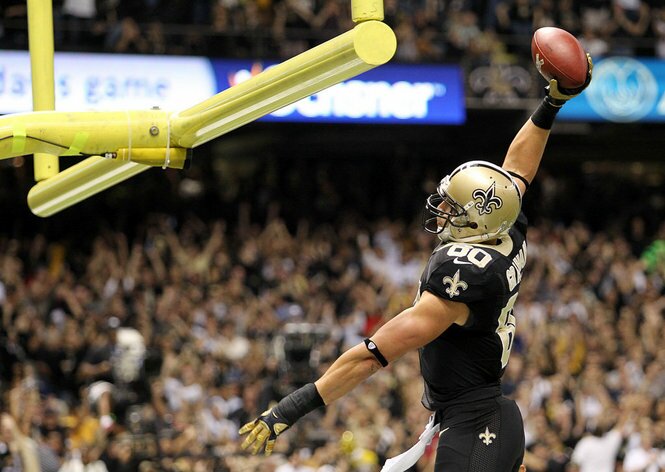Jimmy Graham trade is good for the Seahawks, but maybe not as good as everyone thinks

For the second time in three years the Seahawks have highlighted their offseason by trading for a guy who catches footballs with some reputed proficiency. Jimmy Graham is the newest member of the Seattle Seahawks, and considering he’s widely considered among the very upper crust of the league’s tight end and the Seahawks had a serious need a tight end, the move makes a lot of sense. The team also needed a big, athletic target who could line up wide and in the slot, things Graham is capable of.
Graham has twice eclipsed 1,000 yards receiving, and two years ago he caught 16 touchdowns. In his five-year career he’s averaging roughly five catches and 60 yards per game, which is elite production for a tight end. Graham spent his college days playing basketball primarily at the University of Miami, and has been an extremely unlikely candidate to become one of the league’s elite tight ends. Those basketball skills, however, have made him a favorite target in one of the league’s most productive passing attacks.
That all sounds well and good, but there is an important element that seems to be missing in a lot of the coverage of this trade: The New Orleans Saints passed the ball 205 times more than the Seahawks in 2014. There is a substantial part of Graham’s production that has been aided by the volume of opportunities available. He’s done some extremely athletic things, and presents an athletic mismatch for basically any team facing him, but he’s also been dropped into an ideal scenario for a pass-catcher to thrive in term of counting stats, or even rate stats when per-game is used as the denominator.
It’s worth pointing out that Graham’s cohorts in the Saints passing game also played a role in his success. An argument could be made that the worthy hands of Marques Colston, Brandin Cooks, and other receivers who have been productive around Graham have actually hurt his production by reducing the amount of sub-optimal targets Graham received. By contrast, one could argue that having those guys on the field further stretched defenses who were somewhat predestined to have matchup issues with Graham. Without extensive game-film watching, neither of these points is really proven accurate, so you’ll have to choose which rhetoric to which you subscribe.
Graham probably won’t catch 85 balls – which he’s done in each of the last four years – in Seattle. Not because he’s gotten worse. Not because Russell Wilson can’t get him the ball. There are a lot of reasons that may become all-too-common narratives for why Graham’s production may decrease. The largest driver, probably, will be that the Seahawks pass the ball only two-thirds as often as the Saints have historically.
The contract extension that Graham signed with the Saints last offseason calls for him to make $27 million in the next three years. Of course, NFL contracts are dumb and the Seahawks could get out of this contract before the 2016 season with no additional penalty, but they likely make this trade expecting to pay Graham this whole amount. This isn’t excessive for a player of his Graham’s production, even if that player was a wide receiver (Randall Cobb signed basically the same contract), but it certainly eats into the potential surplus value the Seahawks could receive from a trade like this.
As a team that has found elite talent in the middle and later rounds of the draft, this less-nuanced, blunt-force-trauma approach to player acquisition is interesting, though not entirely unexpected after they traded for Percy Harvin two years ago. Graham is an elite athlete at his position, though for whatever reason his position is valued considerably lower than wide receiver (where he’s lined up often). While his relative athleticism mirrors Harvin, The overall package seems better. The Seahawks are more protected financially and will pay Graham nearly the exact same salary as the overall spend on Harvin in his short stint in Seattle, but without the ugly cap hit if the deal doesn’t work out.
In addition to trading a first round pick and receiving a fourth rounder, the Seahawks traded away Max Unger. Considering his lack of durability and the ability for Tom Cable to seemingly produce offensive linemen from thin air, it doesn’t seem like the loss of Unger will be as difficult on the Seahawks as they expected it would be when they extended him before the 2012 season. The team has also been ostensibly pleased with Patrick Lewis’ as the heir apparent to the position, though a couple of quality free agent centers remain unsigned.
So overall, the Seahawks added a very good tight end. He’s unlikely to duplicate his production from New Orleans, and maybe isn’t as good as his production would indicate. He’s also had health issues, but considering the extent of Unger’s issues it is hard to call Graham’s injuries anything short of a wash when compared to Unger. The Seahawks lost a player in Unger who had provided diminished value due to injury since signing an extension, and a draft pick in bottom of the first round that perhaps no team besides the New England Patriots, who draft 32nd, would value less than the Seahawks.
This is a good trade, a really good trade, but it’s probably not as good as is being opined by most.
 Loading ...
Loading ...
-
Dan
-
Casey McLain
-

